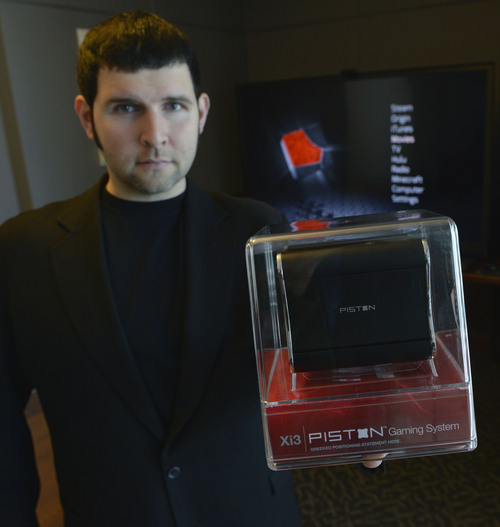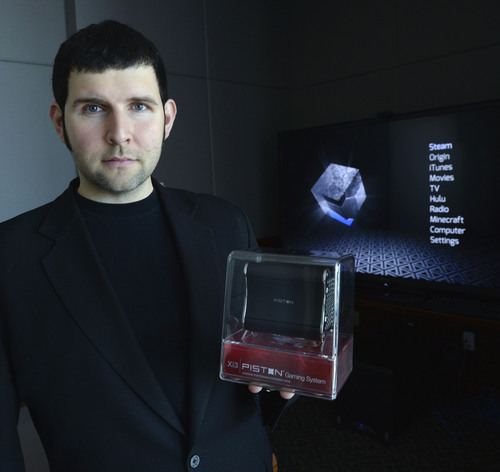This is an archived article that was published on sltrib.com in 2013, and information in the article may be outdated. It is provided only for personal research purposes and may not be reprinted.
While growing up in a Cleveland suburb, Jason Sullivan liked to tinker with anything electronic.
"I would take it apart," the 30-something company president said about whatever device was lying around his house. "I was always into technology products. I was mostly self-trained. I have a great thirst for learning, and I want to know how things work."
That yearning to understand what makes things tick is what has led the college dropout to move to Salt Lake City and start his own computer company, Xi3 Corp., which designs and manufactures "modular" desktop computers.
Xi3, which has spent the last couple of years selling these boxey computers to businesses and colleges, is now entering the consumer market in a big way. It is taking on the likes of Microsoft and Sony with its own computer that is part Windows box and part gaming console.
The PISTON is a small cube-shaped computer that is first and foremost built to play PC games, but it's much more. The Piston went on sale Friday for $999.
"What we want PISTON to become is the centerpiece of the living room," Sullivan said.
Not only can it play computer games from digital PC gaming services such as Steam and Electronic Arts' Origin, but the PISTON can play music through iTunes, Pandora or other music streaming services, run movies through Netflix and other video services, and do anything else a Windows machine can do, including surf the web. It can be hooked up to either a PC monitor or an HDTV.
The power of this all-in-one box is crammed into a case no bigger than a large softball. Sullivan designed it to have the simplicity of a gaming console but with the flexibility and horsepower of a desktop PC.
"This is for the masses, for people who just want to run it. This product is from two worlds — it's half gaming rig and half console," he said. "But unlike a console, you can go and change the settings on a game. On a PlayStation, you can't go in and change the look of the game. It's one setting for everything and you just play it. But if you want to tinker with PISTON, you can."
The PISTON was first introduced at this year's Consumer Electronics Show (CES) in Las Vegas, the world's largest electronics trade show, where it made a big splash with gamers.
Seattle computer gaming company, Valve, is known not only for its blockbuster games such as "Half Life" and "Portal," but also for its No. 1 online gaming store called Steam, which allows customers to purchase and download computer games. Executives at Valve had asked Xi3 to build a "Steam box," a computer designed to use Steam. The result was PISTON, and gamers were enamored with it when it was revealed at the trade show last January.
"It was insane," said David Politis, chief marketing officer for Xi3. "I did 250 press interviews in four and a half days. It was just nuts."
After news hit of the PISTON, Xi3's website received 300 hits per second. "It crashed our website," Sullivan said.
Despite the successful unveiling at CES, Xi3 has its biggest hurdle now. The PISTON was released the same month that two of gaming's biggest giants, Microsoft and Sony, also have launched their next-generation gaming consoles, the Xbox One and the PlayStation 4, respectively. And both of those boxes will be less than half the price of the PISTON.
Xi3 also has faced some backlash after its initial marketing blitz at CES. Recently, Forbes said the PISTON has "arguably a very inflated price for an under-powered machine," and said the company's lack of transparency about the machine's specifications is "borderline deplorable." Meanwhile, popular video game website, Kotaku.com, described the PISTON as possibly "the most confusing product in gaming this year, thanks to some muddled messaging."
Sullivan admits that the PlayStation 4 and Xbox One will be more powerful than the PISTON, but not for long. Xi3 designs computers that are "modular," in other words you can pop out old parts and replace them with newer, faster parts as time goes on. PISTON is designed so that more powerful processors will be available at lower costs that can replace the older CPU.
"There will be a point where we pass them in specification, just not today," Sullivan said.
The idea for Xi3's modular approach to computing, as well as its smaller form factor, came out of Sullivan's work as an IT consultant for big firms such as General Motors and Philips. "I thought if you're going to reinvent the computer, how do you start from scratch?" he said.
From there, Sullivan worked with computer-chip manufacturer Intel on his first computer. He first began work in the Bay Area of Northern California but moved to Salt Lake City where he could find more affordable attorneys to patent his designs. He has since partnered with computer maker Advanced Micro Devices to make his first modular computers and started up Xi3 in 2010 (Xi3 is a computer term for "variable information cubed"). Today, the company is headquartered at the Wells Fargo Towers in downtown Salt Lake City and employs more than 100 people. This month, the Xi3 opened its first mall kiosk at the Fashion Place Mall in Murray where it is selling the PISTON and its other computers. It is exploring the possibility of opening more retail outlets, Politis said.
"It's definitely getting better here," Sullivan said. "I think Utah is a fantastic place. Once I got here and met the people and started to do business here, I fell in love with it. I can't imagine having the headquarters anywhere else."
Twitter: @ohmytech —
What is the PISTON?
It is an entertainment computer about the size of a large softball that can be used as a gaming console and home theater PC. It can be connected to a computer monitor or HDTV. You can use it with a wireless gamepad and/or a wireless keyboard and mouse.
Price • $999. It's on sale now through http://www.xi3.com or at the company's kiosk at the Fashion Place Mall in Murray.
What's inside • A quad-core AMD processor running at 3.2 gigahertz and a separate graphics processor, both on one chip. It comes equipped with 8 gigabytes of RAM (system memory). It comes standard with 128 gigabytes of flash-based storage that will be expandable in the future. It has 12 USB ports and one HDMI port to connect to an HDTV. It does not have a built-in Wi-Fi receiver but an ethernet port to connect to the Internet. It uses a modified version of Windows for its operating system
What does it do? • It can play all PC-based games through services such as Steam and Origin, Electronic Arts' downloadable gaming platform. It can play music through programs such as Pandora and iTunes. It can run movies through video services such as Netflix, Hulu, and Amazon Instant Video and television programs through the over-the-air TV service, Aereo. It also can display a Windows desktop and a web browser to surf the Internet.









